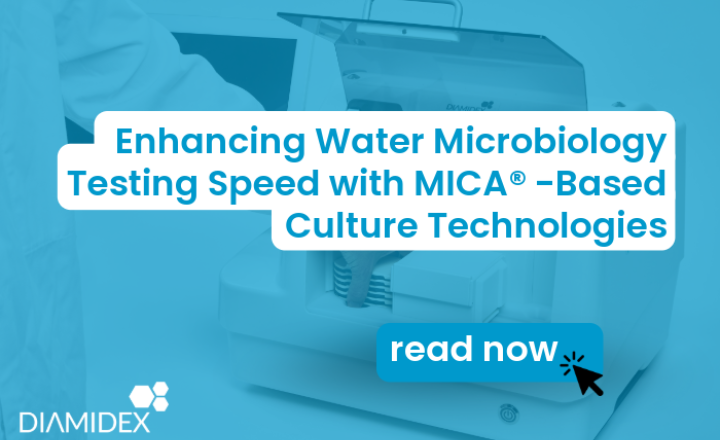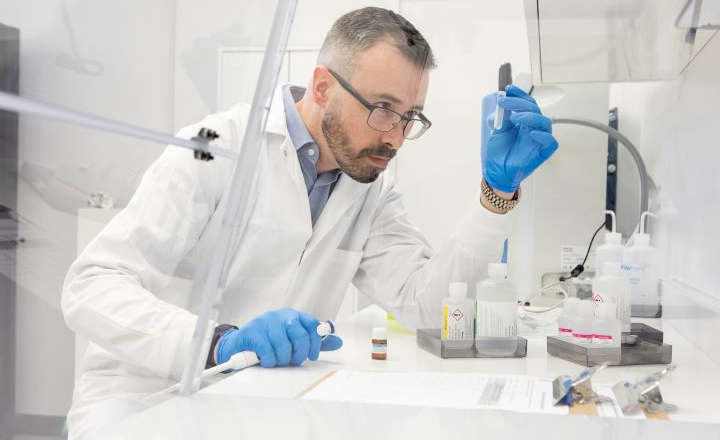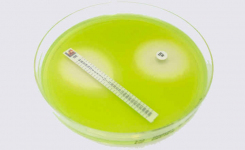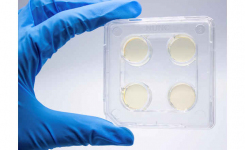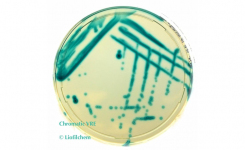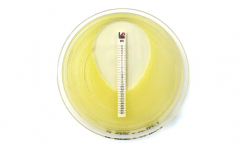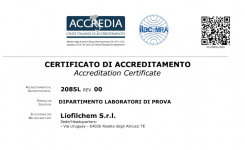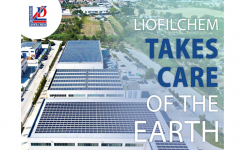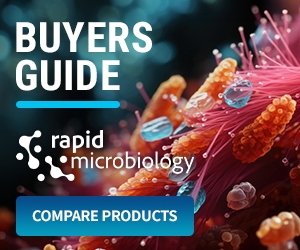Legionella spp. is commonly found in water and its detection is crucial to avoid Legionnaires’ disease, a potentially fatal type of pneumonia contracted by inhaling contaminated airborne water droplets.
Liofilchem produces dehydrated culture media with selective supplements, 60mm agar plates suitable for the membrane filtration method and 90mm agar plates to detect Legionella spp.
Legionella Agar GVPC - 20 plates 60 mm (ref. 163392) and 20 plates 90 mm (ref. 10128)
A selective medium used for primary isolation of Legionella spp from water samples. This medium conforms to the recommendations of ISO 11731 and ISO 11731-2 for the examination of all kinds of environmental samples including potable, industrial and natural waters and associated materials as well.
Yeast extract provides amino acids, nitrogen, carbon, vitamins and minerals. Activated charcoal decomposes hydrogen peroxide, a metabolic product toxic to Legionella spp, and may also collect carbon dioxide and modify surface tension.
ACES buffer (N-2- acetamido-2-aminoethane sulfonic acid) and potassium hydroxide maintain the proper pH for optimal growth. Alpha-ketoglutarate, cysteine and ferric pyrophosphate are incorporated to satisfy the specific nutritional requirements of Legionella spp.
Agar is the solidifying agent. Glycine, vancomycin and polymyxin B inhibit or suppress most non-target bacterial species; both Gram-positive and Gram-negative; including common contaminants such as enterococci, coliform and Pseudomonas spp, while cycloheximide suppresses the growth of yeasts and moulds.
Legionella Agar BCYE - 20 plates 60 mm (ref. 163362) and 20 plates 90 mm (ref. 10051)
A non-selective isolation medium used for the cultivation of Legionella spp. from clinical specimens and environmental samples. The composition of Legionella Agar BCYE (Buffered Charcoal Yeast Extract) complies with ISO 11731.
Yeast extract provides amino acids, nitrogen, carbon, vitamins and minerals. Activated charcoal decomposes hydrogen peroxide, a metabolic product toxic to Legionella spp, and may also collect carbon dioxide and modify surface tension. Alpha-ketoglutarate stimulates organism growth.
ACES buffer and potassium hydroxide are included to maintain the proper pH for optimal growth. L-cysteine is an essential amino acid which is incorporated along with ferric pyrophosphate to satisfy specific nutritional requirements of Legionella spp.
For water testing according to ISO 11731, the choice of method is down to the individual laboratory, as it depends on the type of the sample (e.g., whether the water has low, high, or extremely high bacterial background flora) and the reason of the investigation.
To ensure detection, water samples may be concentrated by membrane filtration or, alternatively, by centrifugation (when the number of legionellae in any given sample is not known, concentration technique are usually performed). Dilution is necessary when high concentrations of Legionella and/or other bacteria are expected. Heat treatment, acid treatment, or a combination of both may also be required before culturing on selective media.
Legionella Agar BCYE + AB - 20 plates 90 mm (ref. 10448)
A selective medium for detection and enumeration of Legionella spp, according to ISO 11731.
Legionella BCYE + AB Agar is a medium used for the selective isolation and enumeration of Legionella spp from water samples and water-related matrices.
Yeast extract provides amino acids, nitrogen, carbon, vitamins and minerals. Activated charcoal decomposes hydrogen peroxide, a metabolic product toxic to Legionella spp, and may also collect carbon dioxide and modify surface tension.
ACES buffer (N-2- acetamido-2-aminoethane sulfonic acid) and potassium hydroxide maintain the proper pH for optimal growth. Alpha-ketoglutarate, cysteine and ferric pyrophosphate are incorporated to satisfy the specific nutritional requirements of Legionella spp.
Agar is the solidifying agent. Polymyxin B and cefazolin are selective agents against contaminating bacteria, while pimaricin (natamycin) is included as an antifungal agent.
Membrane filtration is recommended as a concentration technique when the number of legionellae in the water sample is unknown or not greater than 104 CFU per litre.
Direct plating of the unconcentrated sample is carried out if a higher concentration of Legionella spp is expected. Highly contaminated samples should be diluted and direct plating used before and after the pre-treatment with heat or acid solution.
Legionella Agar BCYE + AB is used in conjunction with Legionella Agar BCYE (ref. 10051), which has the same formulation without antibiotics. Note: Both these two media are inoculated with samples with a low concentration of contaminating organisms; samples containing a high or extremely high level of interfering microorganisms should be tested by using highly selective culture media such as Legionella Agar GVPC (ref. 10128) and Legionella Agar MWY (ref. 10127).
Legionella Agar BCYE w/o Cysteine - 20 plates 90 mm (ref. 10412)
Legionella Agar BCYE w/o Cysteine is a medium formulated according to ISO 11731 and ISO 11731-2 and used for the isolation of Legionella spp. from clinical specimens and environmental samples.
Yeast extract provides amino acids, nitrogen, carbon, vitamins and minerals. Activated charcoal decomposes hydrogen peroxide, a metabolic product toxic to Legionella spp, and may also collect carbon dioxide and modify surface tension.
ACES buffer (N-2- acetamido-2-aminoethane sulfonic acid) and potassium hydroxide maintain the proper pH for optimal growth. Alpha-ketoglutarate and ferric pyrophosphate are incorporated to satisfy the specific nutritional requirements of Legionella spp. which however absolutely need also cysteine to growth. Agar is the solidifying agent.
Culture specimens from swab by rolling the swab over the agar surface to obtain isolated colonies. According to ISO 11731, for confirmation of possible Legionella colonies, typical subculture colonies from Legionella GVPC Agar plates (ref. 10128) onto plates of Legionella Agar BCYE (ref. 10051) and Legionella Agar BCYE w/o cysteine. Incubate plates at 36 ± 1°C for at least two days in a humidified atmosphere (air with 2.5% CO2 can be beneficial for the growth of some Legionella but is not essential).
Examine for growth and fluorescence under long-wave UV light.
ISO 11731 and ISO 11731-2 recommend regarding Legionella as those colonies which grow on Legionella Agar BCYE but fail to grow on Legionella Agar BCYE w/o cysteine.
Colonies of Legionella are often white-grey-blue-purple in colour but can be brown, pink, lime-green or deep-red. They are smooth with an entire edge and exhibit a characteristic ground-glass appearance. Under UV light colonies usually exhibit brilliant blue-white fluorescence. Colonies of L. pneumophila appear dull-green often tinged with yellow.
Legionella MWY AGAR - 20 plates 90 mm (ref. 10127)
Legionella MWY Agar is a medium used for the selective isolation and enumeration of Legionella spp. from water and other environmental sources. This medium is based on BCYE Agar to identify the presence of Legionella spp. in water samples according to ISO 11731.
The addition of charcoal to the medium has the purpose of neutralizing bacterial toxins and other inhibiting substances, increasing the recovery of Legionella spp. Yeast extract is a source of amino acids and group B vitamins.
Aces buffer and potassium hydroxide stabilize the pH of the medium while alpha-ketoglutaric acid, L-cysteine glycine and ferric pyrophosphate supply essential growth factors in achieving the optimal recovery of legionellaceae in a short period of incubation.
The addition of antimicrobial agents gives selectivity to the medium. Bromothymol blue and bromocresol purple colour the colonies; allowing the identification of the microorganisms.






